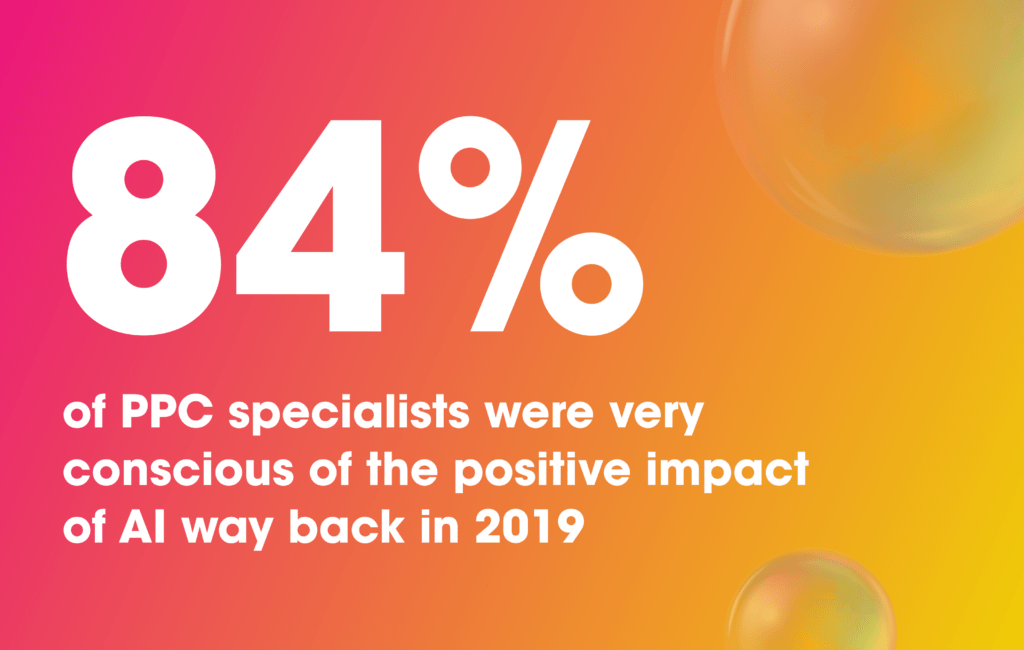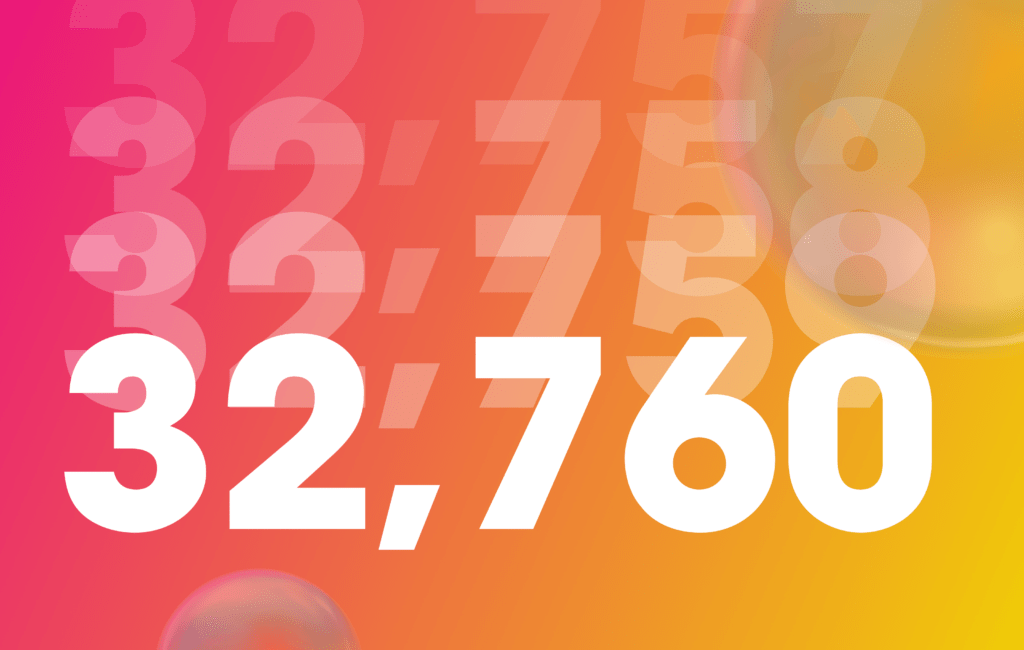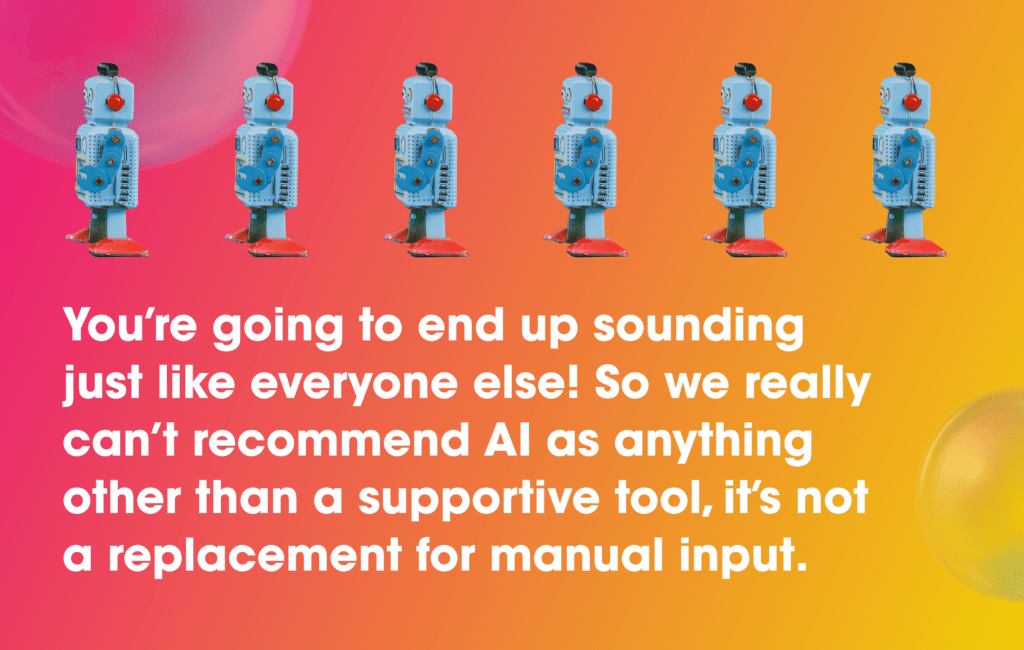2024 is here! Some things are new, but some things are still the same; AI being a talking point in the world of digital marketing is one of the latter!
Last year, we took a holistic look at AI in digital marketing, so to begin the New Year we wanted to dive deeper into a strategy that’s behind the success of many online businesses: paid media.
Paid media and paid ads are big players in the world of digital marketing, and began to embrace AI at a pretty early stage. 84% of PPC specialists were very conscious of the positive impact of AI way back in 2019, and that was a long time before it became a household name. However, AI is now firmly entrenched and more refined… so does that mean it’s now come far enough to run the paid media shop entirely?

We don’t think it’s time to hand over the keys just yet, but AI is certainly an invaluable coworker that has revolutionised how we do paid ads. We‘re also pretty sure that it will continue to help us for many years to come.
So, if it’s so invaluable, why don’t we think that we can just kick back and let it do its thing?
We actually have lots of reasons, and lots of examples, so we’ll take you through them one by one to show you the good, the bad and everything in-between concerning AI and paid media.
AI in the Ad Auction

We’ve been doing PPC for almost two decades, and we love manual bidding. We think it’s still great when it’s used in the right circumstances, but it’s just one of the tools in our repository. Any PPC specialist worth their salt should be able to manage multiple bidding strategies. After all, once an account grows, manual bidding quickly becomes unmanageable. This is the point where AI comes into its own: to manage bidding en masse using automated bid strategies.
However, it’s not just a matter of letting go and leaving the AI to do its thing. There should still be manual input! Picking the right automated bid strategy is vital.
In our experience, we tend to find that the most common choice is between…
- An automated strategy to Maximise Conversions/Conversion Value.
- OR an automated strategy to Target Cost Per Acquisition/Return on Ad Spend.
Both approaches allow a lot of variety and require nuance to maximise their effectiveness, and that’s where the expertise comes in. For example, without enough data to work from, a bid strategy to “maximise conversions” won’t work well (or even be possible). And how do you get that data? You guessed it: by doing the hard work first! AI is good to go once you’ve chosen the direction and have given it the relevant data, and will save you an enormous amount of time, but it still needs that initial direction to excel.
AI in Ad Copy

After the sunsetting of Expanded Text Ads in 2022, Responsive Search Ads (RSA) are the default type of ad, and they draw extensively on AI. During the setup, you can give them up to 15 different headlines, but the ad that a user sees will have been AI-generated from these options when they carried out their search.
If you’re a maths fan, then that one RSA with fifteen headlines and four descriptions represents up to 32,760 different combinations of three headlines and two descriptions! Over time, the AI that generates RSAs will internally A/B test all those options against the others and determine the one that’s the most effective.
Just think about how long it would take you to carry out that process manually!
For high-volume enterprises, AI’s ability to scale is a godsend, but partners with smaller budgets may still want to focus on a smaller selection to find their niche. Once again, it’s all about finding the right setup for your goals, rather than relying on the (admittedly vast) power of AI to replace human intuition.
For example…
- AI algorithms can review an enormous amount of headlines to match specific parts of ad copy to people’s intentions. For instance, if someone has historically searched for “bargains” or “sales”, then the AI algorithm will be able to easily spot this and apply the appropriate weight to price-conscious headlines. It will be able to recognise that these messages closely align with the searcher’s values and interests, and make sure that they are put in front of them as often as possible!
- The modular nature of AI-assisted ads plays a key role in expanding reach. More assets means more options, and more options means more searches. This can help you to achieve a higher Ad Quality. This is the metric in the ad auction that, alongside bid price, dictates where your ad shows up… or if it shows at all!
All well and good so far! However…
- Exploring how changes to your ad copy impact your Impression Share is a vital way to determine if your ad copy is working for both your target audience and Google’s algorithms. Would you really want to take your hands off the wheel entirely?!
PPC is a modular approach. All that extra reach may be good… but there’s also the chance that it might not be, and a human who understands a PPC account is always going to be best-placed to judge what’s appropriate. We therefore highly recommend that you dig into the search terms yourself and drill down to just those that are going to reach who you want to reach. As you keep refining and iterating, you’ll find that you’re getting more volume from the same keywords, and – hopefully – hit your end goal more regularly.
AI in Writing Ad Copy

At this point, we can’t really move on without saying a few words about using AI to write ad copy. We know it’s tempting to do so, and doubtless many people are doing it. But let’s face it, anyone can type “Generate me some headlines for my Google Ads campaign” into ChatGPT. Therein lies the problem; you’re going to end up sounding just like everyone else!
The output of something like Chat GPT is very functional… but also very stiff. Without a human voice, you’ll struggle to build the empathy that’s needed to connect with a reader and show them that you hold the solution to the issue they’re facing. When you’re trying to sell a product or a service to someone, that just won’t fly (particularly in an eCommerce account). As a result, we really can’t recommend AI as anything other than a supportive tool for writing ad copy. Unless you’re happy to blend in with the crowd, it’s not a replacement for manual input.
AI in Data

As we’ve said, AI’s ability to scale and handle high-volume enterprises is a major plus, and that means it’s great at handling large data sets.
Personally, we’re also very grateful for that!
With Smart Shopping having migrated to Performance Max in Q3 of 2022, and Google insisting on a black box approach to these new campaigns, analysts now can’t get access to even some of the most basic data.
We have less to rely on, and therefore have no choice but to put more trust in AI.
As frustrating as this black box approach can be, it really is a case of “adapt or die”. We all have to figure out how to use the data we do still have in order to make good decisions for our partners, and then build approaches that align with whatever is working. This is where AI comes in. The Insights panel still gives you hints as to what is going on in the back end of the platform, largely because machine learning (a form of AI) has identified what it considers to be the most valuable areas. Armed with this information, you can then tack closer towards what it advises, or steer away from it accordingly.
For broader PPC data, you can also analyse your dataset using an AI tool like Claude, but we’d still recommend some caution. We’ve seen it get very close, but after double checking the results it produced we could see that it was still slightly off (albeit by less than 1%). However, our concern is that, if it can be slightly off, it can also be very off! Without a manual review to verify what it says, you’d simply have no way of knowing how accurate the AI has been.
When it comes to AI, the metaphor that we like to use is that of a train. Although we probably now take them for granted, trains are fantastic inventions that have contributed massively to society… but they still need a human being at the helm to keep them on the tracks and ensure that they arrive safely at the desired destination on time.
AI is the same!
Supplementing Your Paid Media with AI
Ultimately, AI’s inclusion within paid media has been growing for years, and there’s no reason to view it as anything other than a positive. Sometimes, you may not even realise that the tool you’re using is reliant on AI.
For instance, we’ve been using ClickCease to determine whether clicks are fraudulent, preventing our partners from being charged and actively saving marketing budget in the process.
What do you reckon plays a key role in this process?
You guessed it; it uses AI, and it improves the quality of the results that we deliver for our partners. What’s not to like?
As far as we’re concerned, AI is the great timesaver. Sure, it needs small daily interventions to make sure it sticks to the intended direction, especially in the long term, but it frees up time for our experts to work on the large-scale, strategic approaches that really turn the good into the great. That’s how we see it changing PPC roles; it gives our experts the time they need to shine.
If you’re weighing up how to get the most out of your paid media efforts in the swiftly-moving landscape of AI-influenced digital marketing, or want to make sure that you’re safeguarding your approach to preserve that all-important human element, then a member of our paid media team would love to talk to you. We can point you in the right direction to find a solution that meets your needs, and even take the burden of managing your accounts off you entirely.
